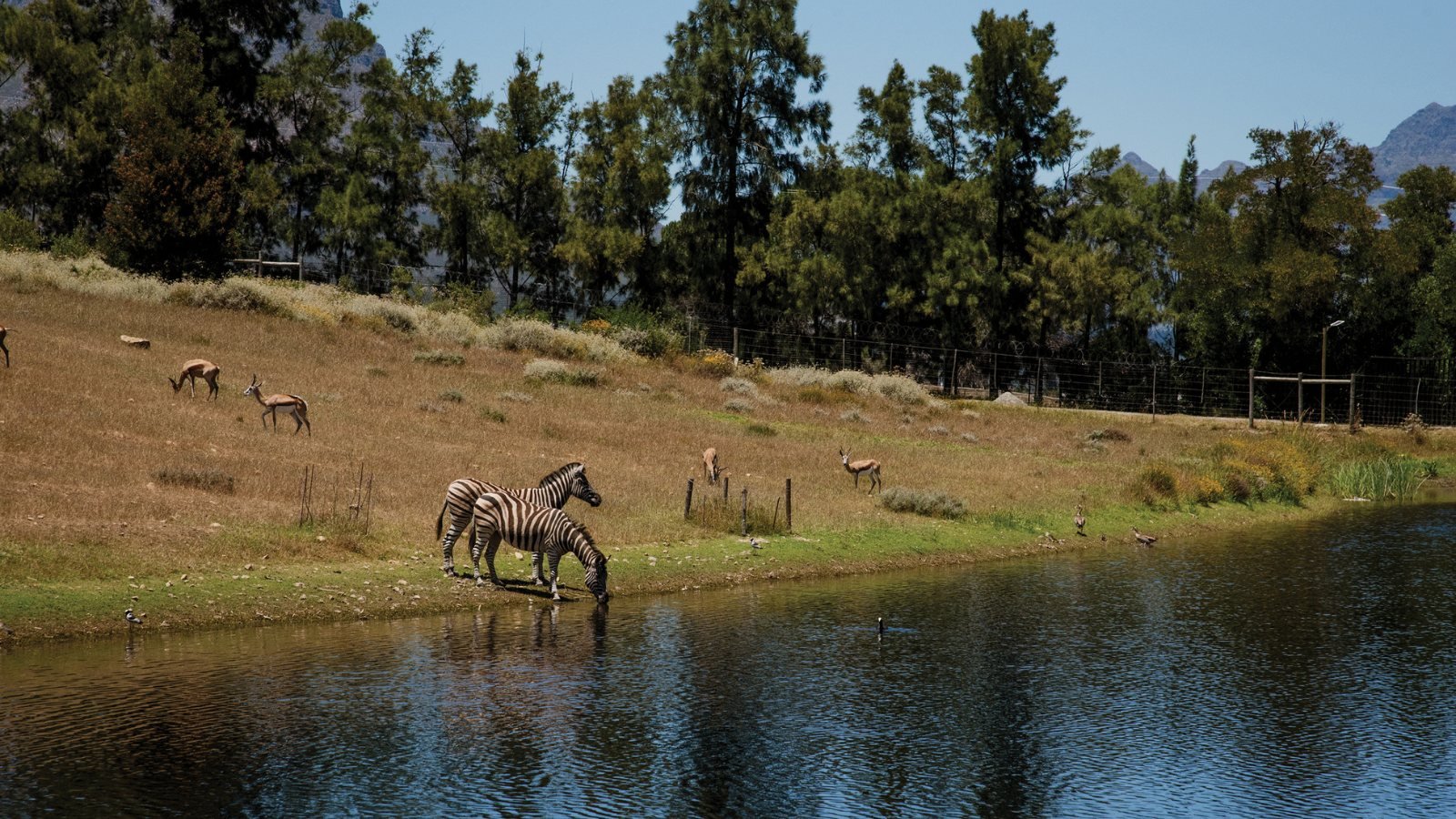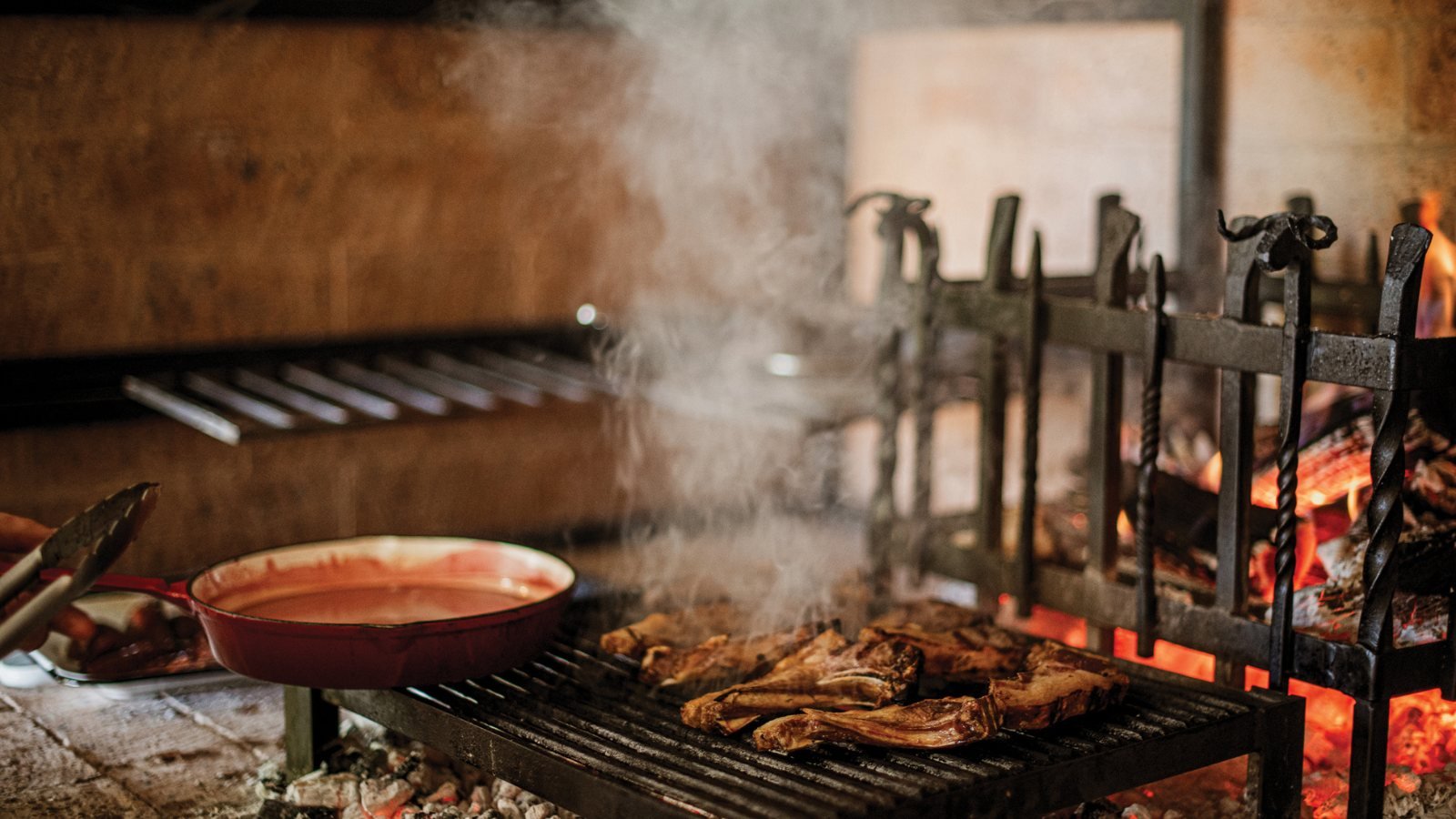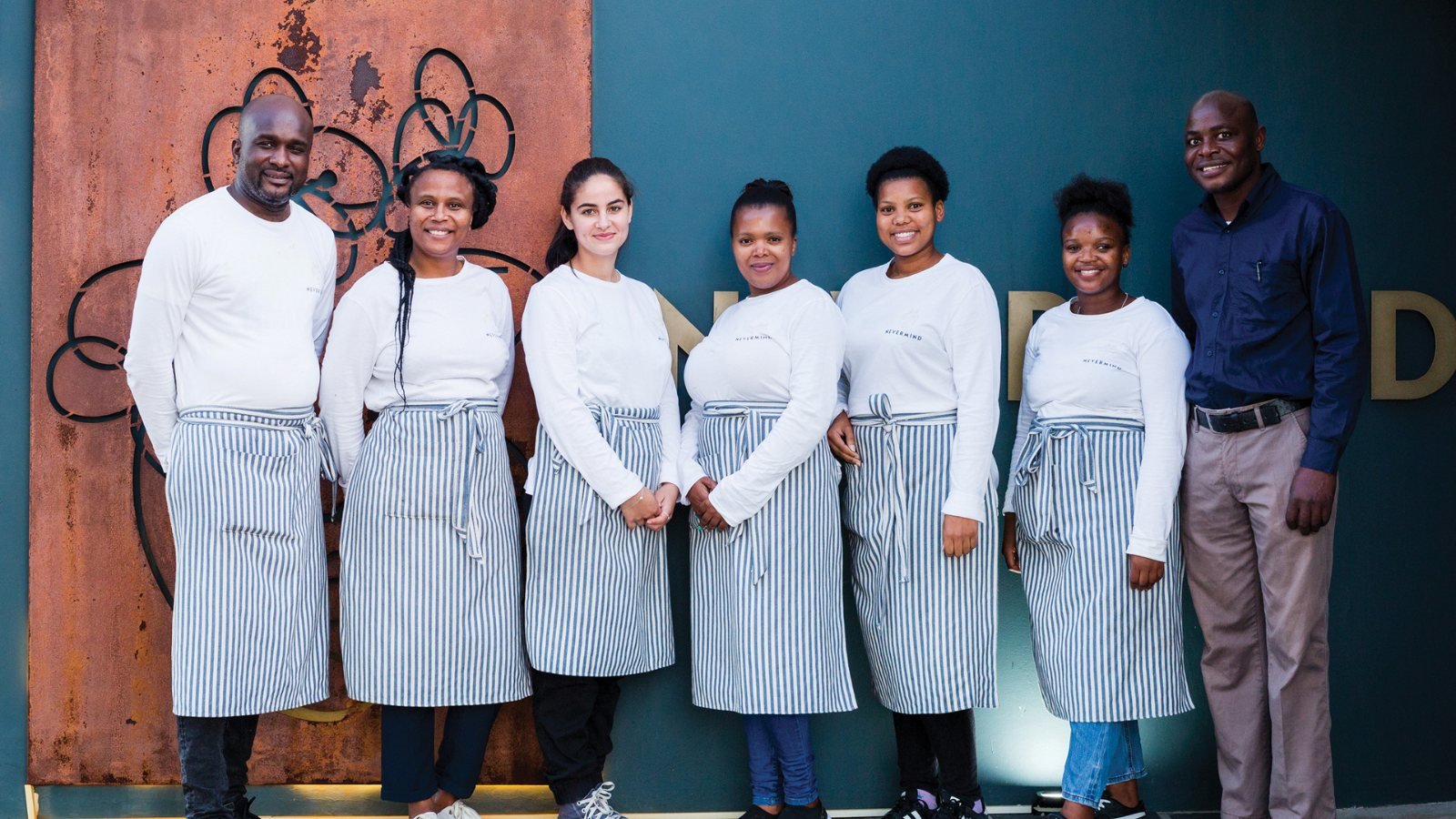Beef of the braai
Trying to avoid using the term barbecue for fear of upsetting their hosts, husband-and-wife team Andrew and Jodie Johnston made every meal count on a trip to South Africa, finding live-fire restaurants of stunning quality wherever they turned
VUUR
The Springboks are the world champions of rugby and South Africans would fancy themselves in any BBQ World Cup, although insisting the ‘sport’ is called Braai. We have been privileged to experience some extraordinary fire cooking experiences in South Africa this year, starting with a restaurant in the Cape Winelands of Stellenbosch called VUUR, which means fire in Afrikaans. And fire was at the heart of everything we ate on an epic culinary tour of this wonderful country.



VUUR is the conversion of an old stable on a wildlife camp on the Remhoogte Wine Estate, so don’t forget the drinks pairings. There is a lunch table for a maximum of 10 people inside, or 12 outside underneath an old oak tree – a seven-course seasonal meal through local meats, fish and seafood, with fire both the workhorse and the show pony.
There is also now VUUR Goose Island beside the dam next door, with its shared chef’s table for up to 16 people and where the local wildlife might join you for a graze. Eating at VUUR is like a great friend cooking in your back garden, only this is food from the fire gods and Stellenbosch is some ‘back garden’.
Beef & Jodie with Shaun Scrooby of VUUR
VUUR chef-owner Shaun Scrooby grew up on a farm and recalls one year cooking a braai every single day, with fire cooking engrained in South African culture. Scrooby uses a variety of woods depending on what he is putting on the menu, with wood as much a food pairing as a vintage wine flight from Remhoogte, run by the Boustred family, in the foothills of the Simonsberg mountain in Stellenbosch.
“I never really studied to become a chef but grew up with a grandmother who cooked a lot and very well. I spent 17 years in the safari industry and this allowed me to travel across Africa and also eat at really good restaurants. I have always loved cooking with fire,” says Scrooby, who likes to “throw everything on the fire to see if it works” be it meat, fish, vegetables or fruit and who handmade all his fire-cooking equipment.
“Dining at VUUR is not just having a meal. We try and make people feel like
they are at our home and share stories about the dishes. We pair these with the wines on the estate and also have the local wildlife to make it a dining experience with a difference – a very long interactive, immersive lunch.”
We started with pickled fish broodjie – toasted baguette with Cape Malay pickled Cape bream, curried onion, peach chutney and curry gel, and crispy red onion – the humble ‘toastie’ elevated to sainthood. Next was fish, with a red stumpnose on the grill with crispy skin, roasted butternut puree and charred broccoli. A palate cleanser came with a plum and vanilla sorbet and a grilled plum gin sour cocktail – all flame-kissed of course.
Even the bread at VUUR is next level. Mosbolletjie is a centuries-old tradition of breadmaking in the Cape and was served with bone marrow butter, plum and rooibos jam. The first meat course was a wagyu flambadou kudu (antelope) and a fire show for the senses as the wagyu fat was poured through a white hot flambadou. It was served with roasted onion garlic and coffee puree, crispy onion, spekboom – a local fynbos leaf that adds acidity – and snow bush salt.
We’re now convinced this is where South Africa’s huge rugby forwards come to dine, for next on our specially curated menu was 112-day-old dry-aged prime rib chop, with black garlic butter, browned and butter-poached shallot, Domino potato and honey and butter carrots. Remember, this is all from the fire. Our final course was braaied pineapple with flamed meringue and vanilla ice cream with a ginger beer foam.
Every course had a perfectly matched wine from Remhoogte to accompany it, be it a Chenin Blanc, Reisling, Pinotage or Merlot/Cabernet Sauvignon from the estate.
Fine fire dining meets authenticity and intimacy in the most stunning setting – an experience we’ll never forget.
Marble
To Johannesburg and Marble restaurant with is large wood-fired grill, all the way from Grillworks in Michigan, USA.
“Marble is a celebration of quintessential South African fare. It embodies South Africans’ love of cooking with fire, a quality that makes our food culture different from the rest of the world,” says founder David Higgs.
Marble- David Higgs
“We have long been fascinated by what makes South African cuisine unique and believe it is down to being meat and flame enthusiasts – the timeworn ritual of cooking on wood fires and gathering with friends, the shared experience in the preparation.”
Our seats faced the open-fire kitchen where our Silent Valley Wagyu and Migo’s Jersey sirloin were starting to take the heat. The waiter brought us the cuts to choose from on a board of sheer indulgence, explaining the aged process. The yellow fat of the sirloin was calling us.
Marble, with head chef Matt Van Niekerk, has a range of signature meat cuts, be it sirloin on the bone, prime rib, T-bone, rib-eye, Tomahawk, hangar or flank.
“We’ve visited every producer, specially selecting every cut on our menu. Renowned for maturity, taste, marbling and distinction, this is some of the world’s most sought-after beef.” We sought, we found and we ate. Sensational, with vegetables also grilled over the fire.
Before the steaks we enjoyed cured kudu, with soy-marinated aubergine, fired grapes, crispy kale and smoked bone marrow, with the fired grapes cutting through the aubergine and the kale, giving it an added texture and the smoked bone marrow a wonderful addition.
Marble Cape Town is expected soon and Marble has a sister restaurant in Johannesburg called Saint, with its Josper, wood-fired oven and grill among the cooking equipment. Any restaurant that describes itself as “the culinary duel of our inner conflict incarnate…the decadent mingling dangerously the divine” has to be worth a visit. Next time Jo’burg, next time.
Koring n Kaf
We’re sorry Italy. But the best pizza we’ve ever had resides at Koring n Kaf in Betty’s Bay on South Africa’s Western Cape.
We all know that staple of every pizza restaurant: the Margherita, right? Wrong. The combination of mozzarella, tomato and basil never tasted as good.
Koring n Kaf has a small menu, which always appeals as you know so much effort has gone into every dish. As well as the Margherita we tried the piri piri chicken pizzette with smoked mayonnaise and pickled cucumber – slices of heaven – as well as the Panuozzo sandwich with cured ham, fior di latte mozzarella, fresh beefy tomato and basil pesto. Humble names, huge flavours, all cooked in the pizza oven or on the Weber barbecue.
A small menu means it would be churlish not to try just about everything. The Sri Lankan prawn curry came with mussels and roti prata and we also sampled the Pizza Dog with lamb kofka, spiced tomato sauce and a herb and yoghurt dressing.
Stefan Roos- Koring n Kaf
Chef Stefan Roos grew up in Somerset West on the Western Cape, with a passion for cooking originally ignited by the open fires of the markets of Mozambique. Travel has informed his dishes all the way, and, after training at culinary school, he worked in Vietnam before heading to Terroir Restaurant in Stellenbosch, followed by Indian restaurant Thali in Cape Town and then as a sous-chef at The Melting Pot and its fusion of global flavours.
“Working with dough became an obsession and I though there could be an opportunity for doing something with bread – big flavours and fire. That’s when I decided to start my own wood-fired eatery in Betty’s Bay, where we had a family holiday home. In Afrikaans, Koring n Kaf means wheat and chaff,” says Roos.
“With constant power outages, we decided to design a small menu, with most of the dishes cooked in the wood-fired oven. Our style of cooking is mostly focused on big punchy flavours. This includes smoking, grilling, fermenting, pickling and working with sourdough.”
Nevermind
It was meant to be just a coffee and a pastry, but never mind; what a find this was and, going beyond breakfast, we immediately booked for dinner when we realised this was more live-fire dining at a glorious location – Seal Point Lighthouse at Cape St Francis on the Eastern Cape.



Wesley Randles is the owner and chef and the lighthouse has been restored so you can stay the night in its wings, having dined next door on local, seasonal ingredients cooked over an open fire.
But first the name – Nevermind. When Covid hit, Randles, like so many, was affected, but built himself back up with the attitude: ‘Never mind, shit happens. So let’s go again.’ And he has done exactly that.
We started with potato bread with whipped tahini and chimichurri, with the chimichurri cutting through the rich creamy tahini.
On Randles’ recommendation we then when for the blesbok tartare. He hunts and butchers his own game and only cooks fish from the bay in front of him. The blesbok was served with Japanese shoyu dressing, crispy rice and toasted nori. The flavours were insanely good, as were the textures.
Tuna was in season so tuna tataki was next, with the tuna rolled and seared on the coals, with a mango and yuzu dressing, chilli oil, coriander and whipped tahini.
We also sampled figs from a local farm, roasted on lemon leaves and roasted paneer with aubergine kasundi – an Asian sauce. The sambal prawns, which shouted beach BBQ, were delicious. It was impossible to ignore the braaied wildebeest loin on the menu, dry-aged in straw and fynbos, with a lovely char and a deep red colour in the middle, served with au poivre sauce. We finished with the Thai-style lamb chops, with a tomato and tamarind dressing and coconut and mint.
Nevermind is a rollercoaster of flavours from around the world, as you look out to sea and dream of epic voyages to the flavour destinations on your plate. What a culinary journey across South Africa we had.














